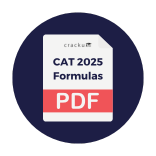CAT 1999 Question Paper
DIRECTIONS for the following questions: These questions are based on the situation given below: There are fifty integers $$a_1, a_2,...,a_{50}$$, not all of them necessarily different. Let the greatest integer of these fifty integers be referred to as $$G$$, and the smallest integer be referred to as $$L$$. The integers $$a_1$$ through $$a_{24}$$ form sequence $$S1$$, and the rest form sequence $$S2$$. Each member of $$S1$$ is less than or equal to each member of $$S2$$.
CAT 1999 - Question 41
Elements of $$S1$$ are in ascending order, and those of $$S2$$ are in descending order. $$a_{24}$$ and $$a_{25}$$ are interchanged. Then, which of the following statements is true?
CAT 1999 - Question 42
Every element of S1 is made greater than or equal to every element of S2 by adding to each element of S1 an integer x. Then x cannot be less than:
DIRECTIONS for the following questions: These questions are based on the situation given below: Let x and y be real numbers
f(x, y) = | x + y |
F(f(x, y)) = -f(x, y)
G(f(x, y)) = -F(f(x, y))
CAT 1999 - Question 44
What is the value of f(G(f(1, 0)), f(F(f(1, 2)), G(f(1, 2))))?
CAT 1999 - Question 45
Which of the following expressions yields $$x^2$$ as its result?
DIRECTIONS for the following questions:
These questions are based on the situation given below: A robot moves on a graph sheet with x and y-axes. The robot is moved by feeding it with a sequence of instructions. The different instructions that can be used in moving it, and their meanings are: Instruction Meaning GOTO(x,y) move to point with coordinates (x, y) no matter where you are currently WALKX(P) Move parallel to the x-axis through a distance of p, in the positive direction if p is positive, and in the negative direction if p is negative WALKY(P) Move parallel to the y-axis through a distance of p, in the positive direction if p is positive, and in the negative direction if p is negative.
CAT 1999 - Question 46
The robot reaches point (6, 6) when a sequence of three instructions is executed, the first of which is a GOTO(x, y) instruction, the second is WALKX(2) and the third is WALKY(4). What are the values of x and y?
CAT 1999 - Question 47
The robot is initially at (x, y), x > 0 and y < 0. The minimum number of instructions needed to be executed to bring it to the origin (0,0) if you are prohibited from using the GOTO instruction is:
DIRECTIONS for the following three questions
These questions are based on the situation given below:
A road network (shown in the figure below) connects cities A, B, C and D. All road segments are straight lines. D is the midpoint on the road connecting A and C. Roads AB and BC are at right angles to each other with BC shorter than AB. The segment AB is 100 km long. Ms. X and Mr. Y leave A at 8:00 am, take different routes to city C and reach at the same time. X takes the highway from A to B to C and travels at an average speed of 61.875 km per hour. Y takes the direct route AC and travels at 45 km per hour on segment AD. Y's speed on segment DC is 55 km per hour.

CAT 1999 - Question 49
The total distance traveled by Y during the journey is approximately




